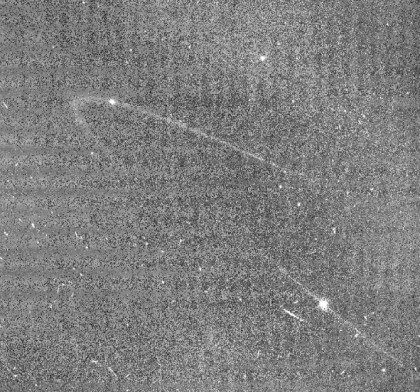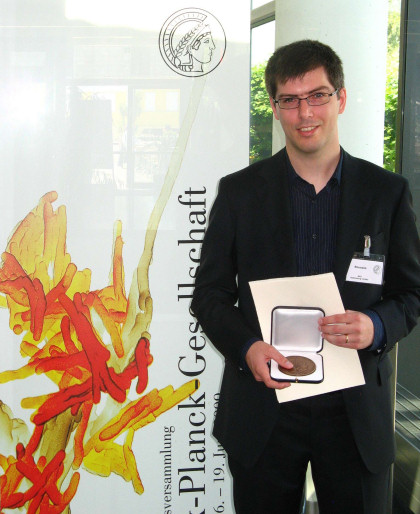Press Release 07/2009 - June 19th, 2009
Two new rings around Saturn
Dr. Elias Roussos from the Max Planck Institute for Solar System Research has been awarded the Max Planck Society’s Otto-Hahn-Medal.
As with several of the small moons of Jupiter, rings of tiny dust particles span the orbits of the small Saturnian moons Methone and Anthe. This discovery was made by Dr. Elias Roussos from the Max Planck Institute for Solar System Research in his PhD-thesis. The conclusion was based on data obtained by an energetic charged particle detector onboard the spacecraft  Cassini. Images produced by a camera verified this prognosis in the autumn of 2008. Saturn’s system of rings is therefore more elaborate than was assumed before. The Max Planck Society has now awarded Roussos the Otto-Hahn-Medal - not only for his results concerning the magnetospheric interaction of Saturn’s moons and ring material, but also for his contribution to a better understanding of Mars’ magnetic environment.
Cassini. Images produced by a camera verified this prognosis in the autumn of 2008. Saturn’s system of rings is therefore more elaborate than was assumed before. The Max Planck Society has now awarded Roussos the Otto-Hahn-Medal - not only for his results concerning the magnetospheric interaction of Saturn’s moons and ring material, but also for his contribution to a better understanding of Mars’ magnetic environment.
At least 60 moons circle the giant planet Saturn. The largest moon, Titan, outshines even the planet Mercury in size; the smallest moons measure only a few kilometers in diameter. On their path around the planet all these bodies leave traces in Saturn’s surroundings: Some moons supply the rings with fresh material by means of meteor impacts or active geysers. Others absorb these dust particles like a vacuum cleaner. The gap between two rings therefore is often identical with a moon’s orbit. Apart from that, the moons also absorb the electrons and ions populating Saturn’s magnetosphere.
"The moons can therefore be used as a tool to study this magnetospheric environment", explains Roussos. Since 2004 scientists from the Max Planck Institute for Solar System Research have been gaining a detailed picture of the electrons and ions surrounding Saturn with the help of the instrument  LEMMS (Low Energy Magnetospheric Measurement System) onboard the spacecraft Cassini. The instrument was developed and built in the laboratories of the institute. On its way through the rings and magnetosphere of Saturn, LEMMS measures these particles’ energies and their spatial distribution. In some regions, however, the instrument could sometimes not detect any electrons or ions: There, large bodies such as moons or rings may have absorbed the charged particles leaving behind a gap.
LEMMS (Low Energy Magnetospheric Measurement System) onboard the spacecraft Cassini. The instrument was developed and built in the laboratories of the institute. On its way through the rings and magnetosphere of Saturn, LEMMS measures these particles’ energies and their spatial distribution. In some regions, however, the instrument could sometimes not detect any electrons or ions: There, large bodies such as moons or rings may have absorbed the charged particles leaving behind a gap.

|
Figure 1: A ring of dust accompanies the moon Anthe on its orbit around Saturn.
|
(Credits: NASA/JPL/Space Science Institute)
|
From this kind of data Roussos was able to predict the existence of two new rings around Saturn. They belong to the small moons Methone and Anthe that are only a few kilometers in diameter. The rings were most likely created by meteorites crashing into these moons. "The rings do not encircle Saturn completely", describes Roussos. "They only span a region of several thousand kilometers before and behind the particular moon and accompany it on its path around the planet." The difficulty consisted mainly in understanding what type of object had led to the gap in the data recorded by LEMMS. After all, after the moon or ring has passed, the gap is again refilled with charged particles. This is much like running a spoon through a pot filled with porridge. The furrow will gradually close again. "In this case, however, the presence of a moon alone could not explain our measurements", says Roussos. A camera onboard the spacecraft Cassini was able to verify this discovery in the autumn of last year.
Roussos applied the same concept to data recorded by LEMMS during a close flyby of the moon Rhea. He was able to assign the short gaps in the counting rate of electrons to small particles that are only one to ten centimeters large and circle Rhea on stable orbits. This is strong evidence for the first system of rings in our solar system that belongs to a moon. A verification with the help of a camera image is very difficult and has not yet been achieved.
Despite these successes, Roussos’ research interests not only deal with Saturn and its rings. In the course of the work for his PhD-thesis Roussos also analyzed data from other space missions such as  Venus Express and
Venus Express and  Mars Express. With the help of measurements performed by the spacecraft Mars Express Roussos was able to study the planet’s magnetosphere in detail. Unlike the Earth, Mars does not have a magnetic field that is created deep within the planet. However, some regions on the planet’s surface are the source of a strong, local magnetization. Together with the solar wind, a stream of charged particles emitted by the Sun, and the planet’s ionosphere, they create Mars’ magnetic environment. Roussos was able to identify signatures of the combined influence of the solar wind and that of the surface magnetization on the magnetosphere.
Mars Express. With the help of measurements performed by the spacecraft Mars Express Roussos was able to study the planet’s magnetosphere in detail. Unlike the Earth, Mars does not have a magnetic field that is created deep within the planet. However, some regions on the planet’s surface are the source of a strong, local magnetization. Together with the solar wind, a stream of charged particles emitted by the Sun, and the planet’s ionosphere, they create Mars’ magnetic environment. Roussos was able to identify signatures of the combined influence of the solar wind and that of the surface magnetization on the magnetosphere.

|
Figure 2: Dr. Elias Roussos has been awarded the Max Planck Society’s Otto-Hahn-Medal.
|
(Credits: MPS)
|
Dr. Elias Roussos studied physics and space science at the universities in Athens and Strasbourg. From January 2005 till February 2008 he worked on his PhD-thesis at the Max Planck Institute for Solar System Research. For this thesis he has now been awarded the Max Planck Society’s Otto-Hahn-Medal. Each year the Max Planck Society recognizes the special achievements of young scientists in this way. In this year 37 researchers in the fields of chemistry, physics and technology received the medal.
Additional Information
 Cassini-Homepage at MPS
Cassini-Homepage at MPS
 LEMMS-Homepage at MPS
LEMMS-Homepage at MPS
Contact
Dr. Norbert Krupp
Press and Public Relation
Max Planck Institute for Solar System Research
Max-Planck-Straße 2
37191 Katlenburg-Lindau
Tel.: +49 5556 979 154
Email: krupp mps.mpg.de
mps.mpg.de
Dr. Birgit Krummheuer
Press and Public Relation
Max Planck Institute for Solar System Research
Max-Planck-Straße 2
37191 Katlenburg-Lindau
Tel.: +49 5556 979 462
Mobil: +49 173 3958625
Email: krummheuer mps.mpg.de
mps.mpg.de
Dr. Elias Roussos
Max Planck Institute for Solar System Research
Max-Planck-Straße 2
37191 Katlenburg-Lindau
Tel.: +49 5556 979 457
Email: roussos mps.mpg.de
mps.mpg.de
